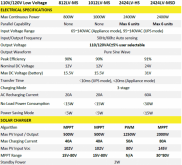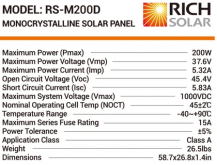Bob O Adirondacks
New Member
- Joined
- Feb 6, 2021
- Messages
- 2
I'm looking to figure out if I can Put (10) 24vt 200watt Rich Solar RS-M200D Solar Panels on My Tiny Home with out damaging anything.


THANKSFOR ALL THE INFO...VERY HELPFUL!Can you look on the back of one of your panels and get it's specifications? That is, it's Voc, Vmp, Ioc, Isc?
Is this your inverter? The 2424LV-MSD, on the far right?
View attachment 37091
I found this rich solar specification sheet.
View attachment 37092
The key numbers you need to compare here is the Voc of the panel, the mppt range of the charger, and the max PV input of the charger. The max PV input is listed as 2000W, so 10 X 200W = 2000, so that is OK.
Now, move on to the Voc of the panels and the mppt range of the charger/inverter. One panel in series would be high enough voltage to charge a 24V battery, but you want to wire in series to minimize voltage drop and copper wire strings. If you put two of these panels in series, you'd get 75.2V charging, and 90.8Voc. That's significantly lower than the inverter's 145Voc limit, and 75.2V fits right into the 30~80V range.
What about 3 in series? That works out to be 37.6V X 3 =112.8V, higher than the 30~80V recommended range. Much more importantly, the Voc of three panels would be 45.4V X 3 = 136.2V. That is really close to the 145Voc limit of the unit. On a cold, frosty morning, expect the Voc to shoot up past 147Voc, according to Midnight's string calculator. So, strings of three panels will likely fry the unit.
So, wire your panels in a 2S5P configuration. With more than two parallel strings, each string should be fused or have a breaker. Using a combiner box with DC breakers would be ideal. DO NOT use AC breakers.
Assume your 2S5P array will produce (2000W/26V charging) X 0.85 lossfactor = 65amps of charging current. Note that 65A is less then the 80A limit of the charger. This would be enough to charge 520Ah lead-acid battery, a 325Ah AGM battery, or a 260Ah Li battery.
Keep in mind the numbers work for the specifications that I found. If your equipment specifications deviate from these, then the advice would also deviate.
Good luck!
Curious why you would say this? I have pulled 1800w continuous off my LV2424 inverter from my batteries.For your inverter, I would be leery of pulling out more than 1200W.
I'm inherently conservative. Sticking with my own 2X rule has worked well for me over the years. I used to push the limits on the ski slopes when I was younger. Now I go a bit slower.Curious why you would say this? I have pulled 1800w continuous off my LV2424 inverter from my batteries.
I guessing your system is in the garage, or is this your stand-alone system that you rely on for all of your power?Ah! Understand completely. Nothing wrong with running conservative.
My system charges Ryobi batteries at this point, so by no means mission critical. I actually have grid power about 75 feet from the garage, but they want $5k to hook it up.I guessing your system is in the garage, or is this your stand-alone system that you rely on for all of your power?


